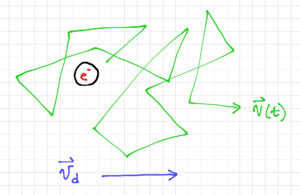Difference between revisions of "Noise in RF Circuits"
| Line 4: | Line 4: | ||
[[File:Electron random movement.png|thumb|300px|Figure 1: Random movement of an electron in an electric field.]] | [[File:Electron random movement.png|thumb|300px|Figure 1: Random movement of an electron in an electric field.]] | ||
Since electronic noise is random, we cannot predict its value at any given time. However, we can describe noise in terms of its aggregate characteristics or statistics, such as its probability distribution function (pdf). As expected from the [https://en.wikipedia.org/wiki/Central_limit_theorem Central Limit Theorem], the pdf of the random movement of many electrons would approach a '''Gaussian distribution with zero mean''' since the electrons will move around instantaneously, but without any excitation, it will, on the average, stay in the same point in space. If we add an electric field, then the electron will move with an average drift velocity, <math>\vec{v}_d=\mu \vec{E}</math>, but at any point in time, it would be moving with an instantaneous velocity <math>\vec{v}\left(t\right)\ne\vec{v_d}</math>, as shown in Fig. 1. | Since electronic noise is random, we cannot predict its value at any given time. However, we can describe noise in terms of its aggregate characteristics or statistics, such as its probability distribution function (pdf). As expected from the [https://en.wikipedia.org/wiki/Central_limit_theorem Central Limit Theorem], the pdf of the random movement of many electrons would approach a '''Gaussian distribution with zero mean''' since the electrons will move around instantaneously, but without any excitation, it will, on the average, stay in the same point in space. If we add an electric field, then the electron will move with an average drift velocity, <math>\vec{v}_d=\mu \vec{E}</math>, but at any point in time, it would be moving with an instantaneous velocity <math>\vec{v}\left(t\right)\ne\vec{v_d}</math>, as shown in Fig. 1. | ||
| + | |||
| + | Aside from the mean, to describe a Gaussian random variable, <math>X</math>, we need the variance, <math>\sigma^2=\left\langle X^2 \right\rangle </math>, or the mean of the square. | ||
== Noise Spectrum == | == Noise Spectrum == | ||
Revision as of 09:54, 25 September 2020
In this module, we consider the noise generated by the electronic devices themselves due to the random motion of electrons due to thermal energy. We see this as thermal noise in resistances, and shot noise in PN junctions. In MOS transistors, we also see flicker noise. This noise is not fundamental, but is due to the way MOS transistors are manufactured, This added uncertainty in the voltages and currents limit the smallest signal amplitude or power that our circuits can detect and/or process, limiting the transmission range and power requirements for reliable communications.
Contents
Modeling Noise
Since electronic noise is random, we cannot predict its value at any given time. However, we can describe noise in terms of its aggregate characteristics or statistics, such as its probability distribution function (pdf). As expected from the Central Limit Theorem, the pdf of the random movement of many electrons would approach a Gaussian distribution with zero mean since the electrons will move around instantaneously, but without any excitation, it will, on the average, stay in the same point in space. If we add an electric field, then the electron will move with an average drift velocity, , but at any point in time, it would be moving with an instantaneous velocity , as shown in Fig. 1.
Aside from the mean, to describe a Gaussian random variable, , we need the variance, , or the mean of the square.




